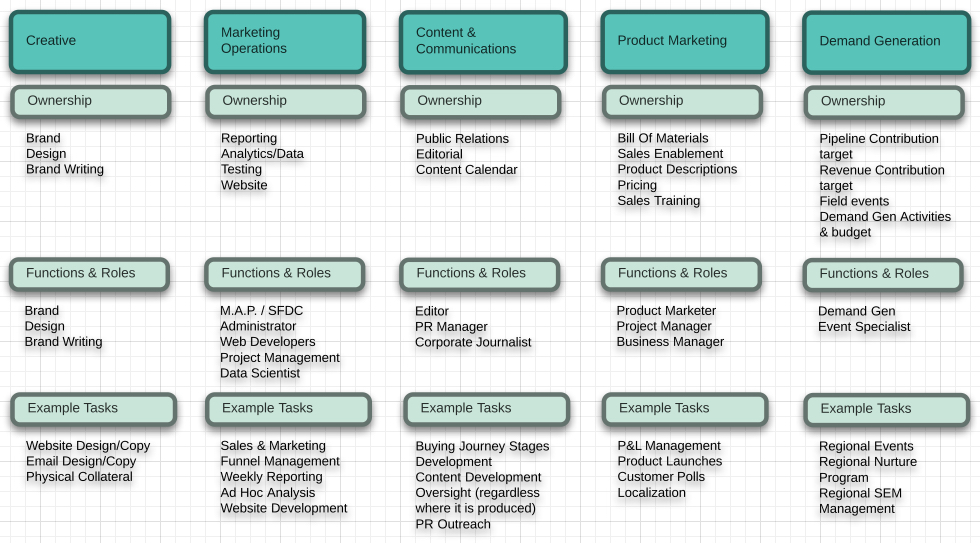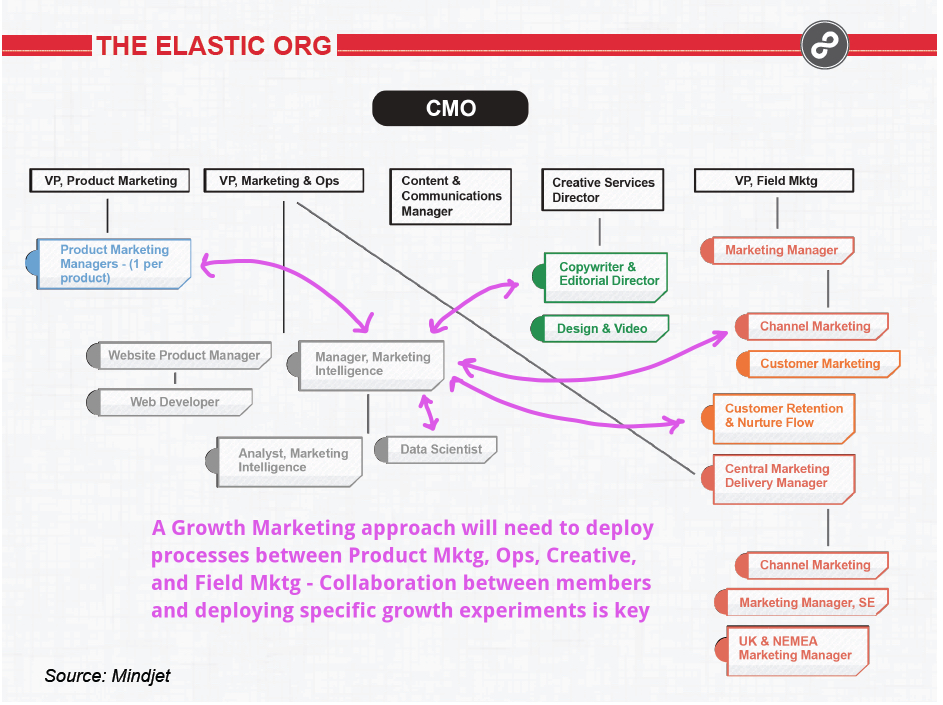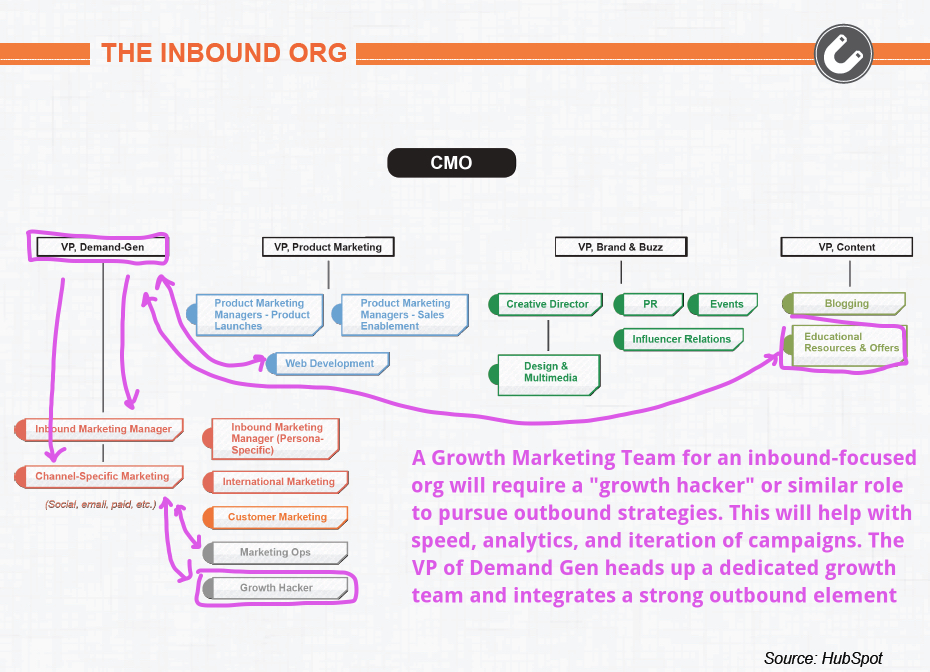B2B SaaS, Software, Tech: Preparing Your Team For Growth – Part 2
You’re not going to win the “marketing lottery” with a campaign that generates hockey-stick growth.
You will probably never go “viral” or be a YouTube sensation.
The days of global vitality is largely over, as channels are becoming more fragmented and niche, while simultaneously disappearing.
For a B2C company, you don’t want to go viral anyway – you want bursts of growth that gives you momentum and vitality does not.
For a B2B company, your target market is not big enough – and that’s a good thing.
But you can, actually, achieve “hockey-stick” growth.
However, that’s only possible if you lay the groundwork with specific strategies, models, and team structure.
If your models, strategies, processes, campaigns, and team aren’t built for growth, you won’t see it.
In the last article I talked about preparing your marketing team for growth by starting to think and strategies about team structure, systems, and process.
Marketing, an online marketing in particular, has changed dramatically in just the past 3 years, and it continues to morph and adjust.
You can actually apply a modified version of Moore’s Law to marketing.
Requirements have shifted, from the focus of big national campaigns with award-winning creative (there’s still a time and place for that) towards blending creative, data and analytics focused, experimentation, and models and team structures that are agile, “lean”, but still impactful.
Your marketing should still deal with owned, earned, and paid media; sales and marketing alignment against pipeline and revenue; go-to marketing programs and partnerships, and so on.
But you absolutely need to make some adjustments to how you’ve used to do things.
Your Constraint To Growth By Marketing Is Process, Not Resources
Every business faces constraints of different kinds, and most marketing teams and leaders tend to assume their major constraint is resources.
But actually, your constraint is process.
Let me explain.
You’ve likely seen and read all about “the lean startup” and being “agile”. It’s a great model for startups to find Product/Market Fit, which in itself is obviously crucial (without it, you have no business).
But can you copy the “lean” model into a process of agility for marketing teams?
Smart people think you can, and have done so: enter the term “growth hacker”.
The process of “hacking” growth can also, in turn, be translated into a process for developing, deploying, and optimizing your marketing campaigns.
This process-focused way of working means you have to adjust your team structure.
And here is the biggest shift marketing leaders have to make in order for their marketing efforts to yield exponential ROI:
You have to fundamentally shift your focus, from resource-oriented to process-oriented. And in turn, you’ll build a stronger, agile, and effective team.
When you’re a team of one or a few, needing to go from 0 to Traction, your processes look one way.
When you’re a team of a few, wanting to go from Traction to Scale, your processes look different.
To illustrate my point, here’s a traditional marketing team resource table:

(Thanks and credit to Jascha Kaykas-Wolff (Mozilla CMO) for the slide in his presentation).
This is the table that need to change, and specifically towards growth processes and models.
I’ve made marks on the areas to start with.
Your Focus On Growth Process Now Unlocks Potential You Didn’t Know Existed
A simple shift of focus can open up new resources or a new way of using resources that were previously hidden from you.
If the priority and goal of your marketing is growth, you need to align your resources with that.
To broad categories of Creative, Marketing Operations, Content & Communication, Product Marketing, and Demand Generation can remain as categories, but if you’re trying to achieve Traction or go from Traction to Scale, your campaigns only job is to make that happen.
So, for either a B2B or B2C company, you should prioritize Demand Generation.
Now, other types of companies can pick this up too, but talking more specifically about B2B SaaS and software companies, funneling sales opportunities to your inside sales team is the prime concern.
If you’re a Startup looking for Traction, or a business looking for Growth, this absolutely applies to you.
You blend inbound and outbound to develop campaigns that attracts, captures, nurtures, and feed MQLs to your inside sales team.
The model just about everyone has adopted so far is the “Predictable Revenue” strategy, by Aaron Ross.
But that’s from 2004, and B2B lead generation has moved on and changed.
Still, it’s a valuable and useful place to start, and I’d tell anyone to start there.
However, if the focus is on growth and process, you still need agility in execution and team.
Why?
Because if cold emailing prospects with an aggressive cadence worked 6 months ago (and it did), it doesn’t work quite the same now (it doesn’t).
The capabilities to change, modify, adjust, tweak, and generate new campaigns and ideas is imperative for your demand generation to ever show results.
You need to develop a process that helps your team develop and deploy growth campaigns, retain their knowledge for future posterity, and the capabilities to quickly make changes.
I’m going to talk more about this in a different article but for now, let’s look at your marketing team.
When & How To Start Adjusting Your Team For Growth Marketing Success
One big question a lot of VP’s of Marketing, Sales, Directors, CMO’s, and so on, asks me is this:
“Should I have a dedicated growth team or make a change to my whole marketing team structure?”
The only true answer is: it depends.
But, there are some general guidelines you can use:
- If you’re in the “Zero (or seed funding) but need Traction” phase, you need a dedicated team.
- If you’re in the “Traction but want to Scale” phase, you usually need a dedicated team but depending on revenue and/or funding, you could set aside a dedicated “growth special team”.
- If you’re in the “Relatively Established but want to 10x our Growth” phase, then you need a dedicated growth team-within-your-team.
Also, if it makes sense to you, you can think of it this way, too:
- If your marketing team is less than 5 people, you make a change to the whole team. You need to treat your team as a dedicated growth team.
- If your marketing team is more than 5 people, you start with a small dedicated growth team. You’re then free to keep it a special team, or roll out changes to the rest of the team later.
Your mileage will vary, but this is a great place to start – it’s always best to move ahead and modulate direction as you go.
Let’s take a look at some actual, real-life marketing teams and how they could implement and experiment with Growth Marketing.
How You Can Make Adjustments With Your Team – Real Examples
You and I are indebted to Jascha Kaykas-Wolff (Mozilla CMO), who’s presentation sparked Mike Volpe of Hubspot to compile another slide presentation with a collection of existing marketing teams.
My work as a Growth Marketing Coach or Consultant involves looking at existing systems, teams, and structures and finding potential for empowering executing on growth campaigns.
The teams I’ve worked with so far are brilliant and experts at what they do. It’s a privilege to meet and work alongside such talented people and teams.
Below, you’ll find a brief discussion on a few, select marketing team structures that lend themselves to adopting a “growth mindset”.
Normally, I mostly work with clients who are looking for Traction or Growth (tend to be startups and companies in the 6-figure range who want to scale), and these examples are of large marketing organizations – but it still applies to you and your company.
How?
You need to understand where Growth Marketing fits in, and how to structure your systems, processes, and team around a growth process and mindset.
You might be a team of 1 or a handful of people, but the roles and capabilities for growth are largely the same.
Growth Marketing Team, Example #1 – “The Elastic Org”
First out is Jascha Kaykas-Wolff, from when he was CMO of Mindjet (but now with Mozilla):

Growth Marketing Team, Example #1 – “The Elastic Org”
Quote from Jascha Kaykas-Wolff:
“As marketing continues to evolve, this organizational structure will adapt to whatever needs come about. Coupled with the adoption of new business processes like Agile Marketing, I believe functional depth expertise, coupled with cross-functional management of the work your team is focused on, will keep a steady stream of ideas flowing, more analytical decisions about which of those ideas to implement, and ultimately create predictability in the outcome of you and your team’s efforts.”
Where Does A “Growth Team” and “Growth Process” Fit In?
The strength of this team is the ability to adapt, evolve, and stay agile. In general, collaboration between the specific members I’ve noted above will be instrumental in pursuing growth.
If one was to set aside a dedicated Growth Team with a structure like this, it would involve the Product Marketing Managers (PMM) being team lead, while a small core of 4 members (creative, channel, analytics/data, and developer) could be given the challenge, resources, and budget to pursue experiments.
Of course, it’s never about throwing stuff against a wall to see what sticks – any experiments are rooted in a scientific approach and staying on brand.
Growth Marketing Team, Example #2 – “The Inbound Org”
This org structure comes courtesy of HubSpot and Mike Volpe (CMO):

Growth Marketing Team, Example #2 – “The Inbound Org”
Quote from Mike Volpe:
“I threw my old org chart in the trash when I joined HubSpot and started from the beginning. We built our entire company for the inbound era, from marketing to sales to service, because the buyer has all the power today and you need to realign your company for that. I think our org chart is the future of the marketing org because of that – we focus on an inbound experience that the buyer drives, with us providing value along each stage.”
Where Does A “Growth Team” and “Growth Process” Fit In?
The challenge for an inbound-centric marketing team is figuring out where, and how, to implement specific outbound growth strategies. Mike Volpe has formed a team that focuses on the inbound experience and it’s working – they recently hit 15,000 HubSpot partners.
Because they’ve already built up such a momentum and existing deal-flow, pursuing growth with a dedicated team would be to expand market share by seeking dominance in various channels.
Also, if you have a dedicated Growth Team, HubSpot could utilize those capabilities for growing new products, like Sidekick. Testing for go-to-market strategies could be a good goal to pursue.
HubSpot also finds itself well beyond the intitial Startup and Traction phase, and is in the Established phase. Where a Growth Team can fit in, more specifically, depends on what their goals are for the next stage of their company.
Growth Marketing Team, Example #3 – “The Funnel-Focused Org”
This next example of from Forrester Research and their CMO, Jeff Ernst:

Growth Marketing Team, Example #3 – “The Funnel-Focused Org”
Quote from Jeff Ernst:
“I try to rationalize this structure by saying that team 1 is above the funnel, team 2 is top and middle of the funnel, and team 3 creates materials for the bottom of the funnel and acts as a service bureau to the rest.”
Where Does A “Growth Team” and “Growth Process” Fit In?
Because of the funnel-focus already existing, you don’t necessarily need a dedicated team. Making room for growth experiments, and having the teams collaborate, could unlock potential in the organization that might otherwise be under-utilized.
Team lead would be the VP of Marketing, and not every team member need to be involved on all experiments, and because of that, it’s important to track, measure, and collect knowledge that everyone has access to. It would probably be a good idea to have review meetings where everyone discusses growth campaigns and their results.
For an organization like this, infusing a “growth mindset” across all teams would yield more than setting aside a dedicated team.
What Does Your Marketing Team Look Like & What’s Next
Of course, these structures are for companies that have mostly gone past the Growth phase, and are fairly established.
But if you’re a Startup, or company in the Traction or Growth phase, you have an advantage if you switch towards a growth-centric model for your processes, campaigns, and team now.
In fact, I would argue that you stand little-to-no chance of sustainable growth unless you do.
Your team might consist of 1, or a handful of people. But models and frameworks like these can yield disproportionate and exponential results for your growth.